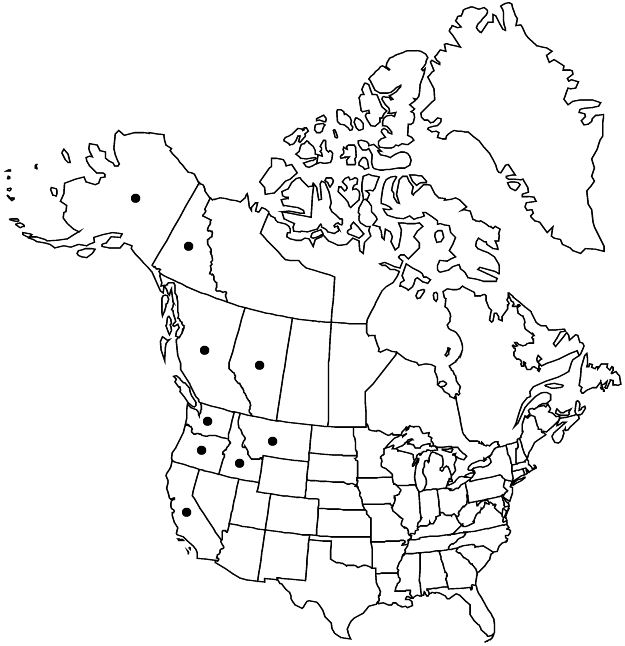Difference between revisions of "Sorbus sitchensis"
Fam. Nat. Syn. Monogr. 3: 139. 1847.
FNA>Volume Importer |
RevisionBot (talk | contribs) m (Bot: Adding category Revised Since Print) |
||
| (5 intermediate revisions by 3 users not shown) | |||
| Line 23: | Line 23: | ||
-->{{Treatment/Body | -->{{Treatment/Body | ||
| − | |distribution= | + | |distribution=Alta.;B.C.;Yukon;Alaska;Calif.;Idaho;Mont.;Oreg.;Wash. |
|discussion=<p>Varieties 2 (2 in the flora).</p><!-- | |discussion=<p>Varieties 2 (2 in the flora).</p><!-- | ||
--><p>The other western <i>Sorbus</i> with rufous indument in the leaf and leaflet axils is <i>S. californica</i>, which differs in its smaller, shinier leaflets, less hairy inflorescences, and shiny winter buds. The winter buds of <i>S. sitchensis</i> are hairier and less scaly at the summit, also glaucous and never shiny or glutinous. In the field, the fresh fruits of <i>S. sitchensis</i> are often pinkish red; fruits of <i>S. californica</i> and <i>S. scopulina</i> are generally orange-red.</p> | --><p>The other western <i>Sorbus</i> with rufous indument in the leaf and leaflet axils is <i>S. californica</i>, which differs in its smaller, shinier leaflets, less hairy inflorescences, and shiny winter buds. The winter buds of <i>S. sitchensis</i> are hairier and less scaly at the summit, also glaucous and never shiny or glutinous. In the field, the fresh fruits of <i>S. sitchensis</i> are often pinkish red; fruits of <i>S. californica</i> and <i>S. scopulina</i> are generally orange-red.</p> | ||
| Line 48: | Line 48: | ||
-->{{#Taxon: | -->{{#Taxon: | ||
name=Sorbus sitchensis | name=Sorbus sitchensis | ||
| − | |||
|authority=M. Roemer | |authority=M. Roemer | ||
|rank=species | |rank=species | ||
| Line 55: | Line 54: | ||
|basionyms= | |basionyms= | ||
|family=Rosaceae | |family=Rosaceae | ||
| − | |distribution= | + | |distribution=Alta.;B.C.;Yukon;Alaska;Calif.;Idaho;Mont.;Oreg.;Wash. |
|reference=None | |reference=None | ||
|publication title=Fam. Nat. Syn. Monogr. | |publication title=Fam. Nat. Syn. Monogr. | ||
|publication year=1847 | |publication year=1847 | ||
|special status=Endemic | |special status=Endemic | ||
| − | |source xml=https:// | + | |source xml=https://bitbucket.org/aafc-mbb/fna-data-curation/src/2e0870ddd59836b60bcf96646a41e87ea5a5943a/coarse_grained_fna_xml/V9/V9_748.xml |
|subfamily=Rosaceae subfam. Amygdaloideae | |subfamily=Rosaceae subfam. Amygdaloideae | ||
|tribe=Rosaceae tribe Gillenieae | |tribe=Rosaceae tribe Gillenieae | ||
| Line 69: | Line 68: | ||
}}<!-- | }}<!-- | ||
| − | -->[[Category:Treatment]][[Category:Sorbus sect. Tianshanicae]] | + | --> |
| + | |||
| + | [[Category:Treatment]] | ||
| + | [[Category:Sorbus sect. Tianshanicae]] | ||
| + | [[Category:Revised Since Print]] | ||
Latest revision as of 17:19, 6 November 2020
Shrubs, 10–40 dm. Stems 1–8; bark initially reddish purple to brownish gray, becoming grayish red; winter buds red-purple to red-brown, conic to ovoid, 8–13 mm, dull, slightly glaucous, not glutinous, sparsely or densely villous, hairs primarily rufous. Leaves pinnately compound; stipules persistent, sometimes deciduous, hairs rufous; blade paler abaxially, dull blue-green, usually slightly glaucous, rarely faintly shiny adaxially, leaflets 7–13, opposite, sometimes subopposite, oblong to narrowly elliptic, sometimes oblanceolate, ovate, or obovate, 1.8–6 × 0.6–2.5 cm, l/w ratio 1.9–3.5, margins entire or finely to coarsely serrate, sometimes doubly serrate, apex obtuse or acute, surfaces soon glabrous, leaf and leaflet axils hairy, hairs rufous. Panicles 12–80-flowered, rounded, 2–8 cm diam.; peduncles glabrous, glaucous, or sparsely to densely villous, hairs primarily rufous. Pedicels glabrous, glaucous, or sparsely to densely villous, hairs primarily rufous. Flowers 11–17 mm diam.; hypanthium glabrous, glaucous, hypanthium plus sepals 3–4 mm; sepals 1–2.2 mm, margins lightly to moderately ciliate, hairs rufous or whitish, infrequently glandular; petals white, rarely pinkish, rhombic to ovate, 4–7.5 mm; stamens 15–20; carpels distinct, apex concave, depressed, or slightly conic and truncate, styles 3–5, 1.5–3.2 mm. Infructescences glabrous, glaucous, or villous. Pomes pinkish red or red (often appearing slightly purplish), subglobose to broadly elliptic or obovoid, 7–13 × 7–13 mm, dull, glaucous; sepals inconspicuous, incurved. Seeds red-brown, ovoid to ovoid-lanceolate, oblong or elliptic, 3.4–5 × 2.2–2.9 mm, symmetric or trigonous, slightly flattened.
Distribution

Alta., B.C., Yukon, Alaska, Calif., Idaho, Mont., Oreg., Wash.
Discussion
Varieties 2 (2 in the flora).
The other western Sorbus with rufous indument in the leaf and leaflet axils is S. californica, which differs in its smaller, shinier leaflets, less hairy inflorescences, and shiny winter buds. The winter buds of S. sitchensis are hairier and less scaly at the summit, also glaucous and never shiny or glutinous. In the field, the fresh fruits of S. sitchensis are often pinkish red; fruits of S. californica and S. scopulina are generally orange-red.
Selected References
None.
Key
| 1 | Leaflet margins toothed apically, serrate for more than 1/2 their length; petals white. | Sorbus sitchensis var. sitchensis |
| 1 | Leaflet margins entire or toothed apically, serrate for less than 1/2 their length; petals white or pinkish. | Sorbus sitchensis var. grayi |